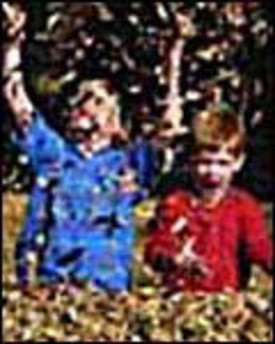 |
||
|
|
A stress encounter group I know, recommends sitting quietly and watching the colored leaves fall. Steal a moment, take a deep breath and a few second pause to the stress of our new electronically chopped up micro-time.
Slowly The Leaves Float To The Ground on sunny Indian-summer days. Sometimes they fly with fury in a whipping wind. You can meditate. Maybe. But in the backyard, the sheer bulk of leaves that flutter down is overwhelming! Who hasn’t dragged endless bags of them from one place to another, again and again? To reduce this nagging yard work, first decide which leaves have to go and which can be left where they fall.
Leaves That Have To Go – On walks they become slippery when wet. Too deep on perennial beds can cause crown rot. Leaves serve as comfy snow suits for many fungi and insects. On lawns they cause problems. And what about our current mantra to “Make Compost”?
 |
||
|
|
You Can Leave The Leaves under trees, shrubs and on sturdy ground covers. Over the winter the leaves will self-destruct into compost. In spring, instead of paying for another 2 inches of new bark mulch, you need to just sprinkle enough of the fancy red stuff to cover over the leaves. Experiments have repeatedly shown that the larger the mulched area under any tree, the healthier it is and the faster it grows. Old beech trees really benefit from letting the leaves stay because they feed the biotic activity necessary for healthy roots.
Do Definitely Throw Out (in the garbage), any plants that are troubled by diseases or insects. Those needing fall sanitation include roses, iris, peony, phlox, stalks of spent perennials, vegetables, raspberries, and fruit trees. (If you can get to it, I never truly do finish it all.)
 |
||
|
|
If You Really Love Your Lawn and want decent grass, you have to accept the dreaded leaf chore. But don’t just rush out in a swivet and rake![]() the endless fluffy fellows. First mow through them, right on the grass, because this immediately reduces their volume by half. Collect the chopped up bits in the lawnmower bag and pile them up. In 2 weeks this pile will shrink by half again. By spring it’ll reduce by another half. The mountain of October leaves will have become a few inches of good compost for summer mulching.
the endless fluffy fellows. First mow through them, right on the grass, because this immediately reduces their volume by half. Collect the chopped up bits in the lawnmower bag and pile them up. In 2 weeks this pile will shrink by half again. By spring it’ll reduce by another half. The mountain of October leaves will have become a few inches of good compost for summer mulching.
To Make A Compost Pie, throw on some dirt between each foot of leaves and grass clippings. Add water if they’re dry. Make as many layers to the pie as you have patience for. You can make compost pie on the vegetable bed if you add a sprinkle of lime or ashes. It can be dug in late November, and the soil formed into raised furrows all ready for earlier spring planting. Raised furrows dry and warm up faster. Or you can wait and just pull the mulch aside in spring. The ground will be soft and ready to plant (which explains the simple essence of that supposedly mysterious science called no-till farming).
Credit: Mother’s Garden




























